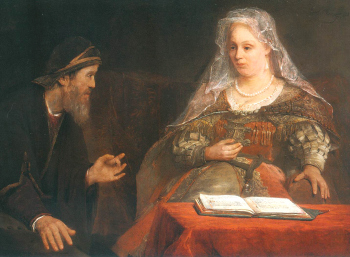Esther is one of several writings, such as the Psalms and Proverbs, in the Biblical division of Scripture called "the Writings."
Date Written, Location
This book was written by both Esther and Mordecai roughly around 473 B.C. in ancient Persia. All the events in the book take place within Persia.
The Authors
This book has two authors. The first is Persian Queen Esther who was a Jew from the tribe of Benjamin (see Est. 7:3 - 4, 8:5 - 6).
The second author, Mordecai, was a Jew from the tribe of Benjamin. He was the great-grandson of a man named Kish who was taken captive in 597 B.C. during Nebuchadnezzar's second attack of Jerusalem and Judah (Est. 2:5 - 6).

Time Period
Persian King Artaxerxes (also known as Ahasuerus or Xerxes I the Great) ruled the empire from October 486 to August 465 B.C. The book of Esther begins in the third year of his reign (Est. 1:3) or 484 B.C. It ends roughly during the king's fourteenth year of rule (see Est. 3:7, 12 - 13, 9:1) or 473 B.C.
Important People in Esther
King Artaxerxes (Ahasuerus), Vashti, Esther, Mordecai, Haman.
Esther Chapter Outline
Chpt. 1: Persia's King Ahasuerus hosts a huge feast for those in Shushan. At feast's end his request to have Queen Vashti show her beauty to the people is rejected. The king, greatly angered at her disobedience, removes her from being queen.
Chpt. 2: Young virgins are sought for the king to replace his rejected queen. One of these women was Esther, a Jew, whose relative Mordecai had raised her since her youth. Esther is ultimately selected to become the new queen. Sometime later Mordecai, who is now a royal official, foils a plot against the king's life.
Chpt. 3: Haman is promoted to Prime Minister over the empire. In spite of the king's command, Mordecai does not kneel before and honor Haman.
In his rage Haman looks to destroy both Mordecai and all the Jews. He waits for his "lucky" month to arrive and approaches the king with false accusations. The king approves of his plan to destroy all the Jews, which allows him to issue an edict that all Jews should be killed eleven months in the future on Adar 13.
Chpt. 4: Mordecai and the Jews mourn over the official edict to murder them. Mordecai gives a copy of the edict to Queen Esther and tells her to seek help from the king as even her own life is in danger. Esther requests Mordecai and the Jews, as well as her own maidservants, fast for three full days before she risks coming before the king unsummoned.
Chpt. 5: Esther receives the king's favor to approach him. She asks that he and Haman attend her banquet. At the banquet she requests they attend another banquet. Haman boasts to his family about all the honor and riches he has received. Haman's wife and friends suggest he build gallows to hang Mordecai and have him hung before attending the royal banquet.
Chpt. 6: The king discovers, on a sleepless night, that Mordecai had saved his life. He also learns that he was never rewarded for this act. The king, without divulging who he wanted to honor, asks Haman (who was ready to request Mordecai be hanged) what he should do for someone who delighted him.
Haman, mistakenly thinking the king wants to reward him, suggests the person to be honored be dressed in royal attire, given a crown, and paraded through the streets. The king likes his suggestion and commands that he arrange for Mordecai to be so honored! Haman, after he completes this task for his enemy, is brought to Queen Esther's banquet.
Chpt. 7: Queen Esther, at her banquet, finally reveals to the king that she is a Jew and that she and her people have been slated to be killed. She also reveals that the man behind the effort to commit mass murder is Haman!
The king, now full of wrath at what he heard, temporarily leaves the banquet hall. Haman, who knows he is a doomed man, begs Esther for mercy. When the king arrives back, he sees Haman at Esther's couch and assumes he is assaulting her! Haman is dragged to the gallows he had prepared for Mordecai and hung.
Chpt. 8: Esther requests the king's help to nullify the edict commanding all Persian Jews be killed. The king, unable to rescind the edict he approved, allows Mordecai to write a letter to all of Persia's provinces.
The letter Mordecai writes, with the king's seal, grants all Jews in the kingdom the right to defend themselves and even kill those looking to fulfill the king's original decree. They are also allowed to plunder the property of those who seek their harm.
Chpt. 9: The Jews throughout Persia's territories successfully defend themselves against those who want to harm them. Even Persian royal officials, officers and governors helped the Jews stay alive. Haman's ten sons are also hanged.
Mordecai sends another letter to Persia's provinces commanding that Adar 14 (starting sunset of Adar 13), called Purim (Esther 9:26), be celebrated annually to remember the Jews escaping total destruction.
Chpt. 10: This last chapter of Esther reveals that Mordecai's rise to power was written in the chronicles of the Persian kings.